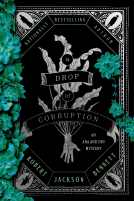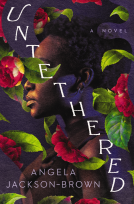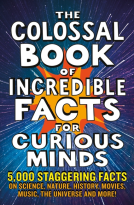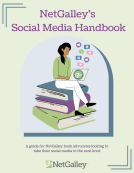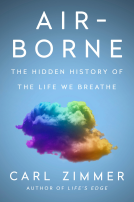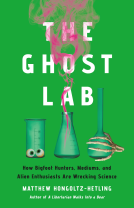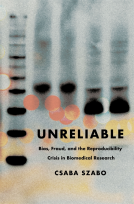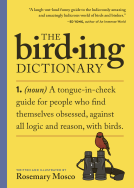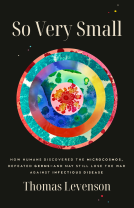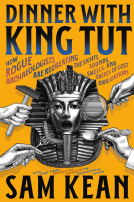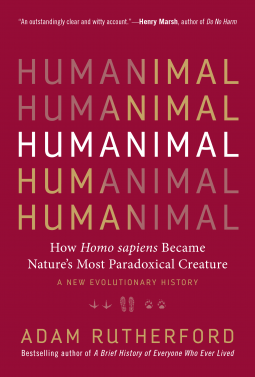
Humanimal
How Homo sapiens Became Nature’s Most Paradoxical Creature—A New Evolutionary History
by Adam Rutherford
This title was previously available on NetGalley and is now archived.
Send NetGalley books directly to your Kindle or Kindle app
1
To read on a Kindle or Kindle app, please add kindle@netgalley.com as an approved email address to receive files in your Amazon account. Click here for step-by-step instructions.
2
Also find your Kindle email address within your Amazon account, and enter it here.
Pub Date Mar 19 2019 | Archive Date Apr 02 2019
Talking about this book? Use #TheBookOfHumans #NetGalley. More hashtag tips!
Description
This file is NOT currently available for Kindle. We apologize for any inconvenience. If you have difficulties with downloading, please email us (at publicity@theexperimentpublishing.com) for assistance or leave a note in lieu of a review rating.
The author of A Brief History of Everyone Who Ever Lived investigates what it means to be human—and the ways we are (and aren’t) unique among animals
We like to think of ourselves as exceptional beings, but are we really more special than other animals? In this original and entertaining tour of life on Earth, Adam Rutherford explores how many of the things once considered to be exclusively human are not: We are not the only species that communicates, makes tools, uses fire, or has sex for reasons other than procreation. Evolution has, however, allowed us to develop a culture far more complex than any other observed in nature. Humanimal explains how we became the creatures we are today, uniquely able to investigate ourselves. Illuminating the latest genetic research, it is a thrilling account of what unequivocally fixes us as animals—and what makes us truly extraordinary.
Available Editions
| EDITION | Other Format |
| ISBN | 9781615195312 |
| PRICE | $25.95 (USD) |
| PAGES | 272 |
Featured Reviews
This book does difficult work of making complex topics simpler and interesting at the same time, so that non technical reader may enjoy and learn a lot of things about our past and how it unfolded. Book is engaging description of how humans used tools, language, teachings,fire and art to conquer the earth and how we became better than our cousin apes and all the mammals, who share many similar genetic features.
After a slow first chapter, book becomes rainbow of fabulous facts about us and animal kingdom. Chapters on sex life of man and animal kingdom is very good with details you will be surprised to know. Book dissects brains of man and other species in parallel. Illustrations that pop out at various points are pleasurable bonus.
Thing which one may dislike is complex discussion of genes and genetics and too much Darwin. Also, description of cannabalism, rape and abnormal sexual behaviour in animals may be distracting force for some readers.
Overall, a feast for science and non fiction lovers with a lot of new information but little complex nodes in between.
 Maxine M, Reviewer
Maxine M, Reviewer
The effort to distinguish humans from the rest of the animals has filled volumes since before Darwin took his fated voyage on the HMS Beagle: tools, war, sex habits, language. In his latest book, The Book of Humans: The Story of How We Became Us, geneticist Adam Rutherford looks at each of these things and how our behaviour is different to and often surprisingly similar to other animals. The use of tools eg. was once seen as the main distinguishing factor that made us unique but scientists have documented many cases of animals using tools, monkeys using twigs to get at hidden insects and, as recently as 2017, some birds of prey were seen picking up sticks from brush fires and dropping them in dry grass to drive small animals into the open for easy pickings. As to sex habits, it has been argued in the past that humans were the only animals that had sex for reasons other than procreation but that is no longer the case. As Rutherford points out, there are few sexual habits of humans that haven't been observed in other species - here, I will freely admit I now know more than I ever thought I needed or wanted to know about the sex habits of dolphins and otters - turns out they can be really big jerks in the sack.
In the end, Rutherford shows we really aren't that much different from other animals except in our ability, not only to learn but to teach and not just our closest kin but strangers. He also shows how we haven't really evolved genetically from our ancient Homo Sapiens ancestors or even likely Neanderthal or Denisovans - they had a capacity for language, for art, for symbolism just as we do now. He posits that it was increased population rather than genetics that is responsible for the rise of civilization, that as populations increase, so does our knowledge and skill-sharing.
Adam Rutherford has become one of my favourite science writers - he not only makes the science accessible to the scientifically illiterate like myself but, thanks to his use of humour, he makes it fun to read. The Book of Humans is no exception. It is well-written, well-documented, clearly explained and interesting. I would even call it entertaining, a word I'm sure most would agree is rarely used to describe a book of science.
<i>Thanks to Netgalley and The Experiment for the opportunity to read this book in exchange for an honest review</i>
An interesting take on a well-chewed subject. What makes humans human - how do we differ from all our relatives, from the great apes to bacteria and viruses? It's mostly, though not entirely, about behavior - cultural transmission of information and habits, and how that is not _quite_ unique to humans. Use of tools, making of tools, even use of fire...fashion and pointless decoration, too. And considerable discussion of sex, how our behavior is similar to and different from that of various animals - with the repeated caveat that while you can ask a human why they're doing something (and sometimes get the answer "because it feels good"), you can't ask an animal why they're doing it, or how they feel about what they're doing (this applies to sex, but also to tool use, and many other behaviors). I also found the review of (relatively) recent archaeological discoveries interesting - a subject I enjoy, but my knowledge is rather behind. This is my first Rutherford, it won't be my last. I received this book through Netgalley in return for a review.
Humanimal is the popular science book by Adam Rutherford, which discusses both the role of evolution and genetics in the story of humans, complete with beautiful illustrations by Alice Roberts.
Fascinating anecdotes run throughout the book; whether that be pyromaniac birds, homosexual giraffes or Obama-recognising sheep. However the book is much more than just animalistic anecdotes, but presents a well-balanced discussion of the biology that shapes us. Where Rutherford does particularly well is balancing the cognitive dissonance we can have when studying animals. We are guilty of both anthropomorphize animals, projecting the human condition onto animals, as well as the opposite—
considering ourselves superior, when in fact we may not be as distinct from the animal kingdom as we would like to believe. These issues can be interesting to consider when thinking about zoology—that it is one animal studying another.
The book is well written, and accessible—the level of scientific discussion is both sufficiently clear for beginners to the field but lively enough to interest those with a scientific background. In addition the focus is broad, combining archaeology, neurology, zoology, genetics and beyond.
Another great book by Rutherford that will not disappoint
I loved this book. I wasn’t surprised, however, since I had read two other books by Adam Rutherford - “A Brief History of Everyone Who Ever Lived” and “Creation” and had loved those as well. In this book, Rutherford makes the case that humans are animals and that many of the ways we behave is also seen in the animal world. Rutherford writes with a conversational tone and he makes the science completely accessible. Humanimals is well written and with the same sense of humor that Rutherford displayed in his other books. And again, the footnotes are worth reading.
Thank you to NetGalley, the Experiment, and Adam Rutherford for an ARC ebook copy to review. As always, an honest review from me.
Like:
- Opportunity to learn even more about evolution
- Shows the specific genetics and behaviors that contribute to evolutionary change
- Many visuals to help with understanding of the text
Love:
- Everyone can learn something from this book
- Complex information that’s written in an easy to understand way. You don’t need a college degree in science to understand the information
Dislike:
- Not so much a dislike, but more of a warning- there’s chapters on sexual activity ( because how else are new animals and humans created) It goes in depth into various sexual activities, mating practices, and genital touching. So heads up, if you end up listening as an audiobook without headphones.
Wish that: —
Overall, a well written, comprehensive book about the step by step process of evolution. Written in an interesting easily accessible manner. I definitely recommend if you’re interested in the topic!
Humanimal is an examination of what it means to be human from a genetic and biological standpoint, and how our definers mirror those of what we consider ‘animals.’ Rutherford presents a well-researched guide to humanity – from our bodies to our behaviors to our cultures. Human history is a long, drawn out story and Humanimal makes it fascinating.
You’ll learn a lot about the ways different animals match human behaviors and genetic makeup. How do animal brains compare to human brains? How does sexuality manifest in animals as compared to humans? Does the usage of tools actually work as an indicator of human intellect, given the fact that so many animals have created crude tools of their own? The similarities are surprising at times, showing how much we truly are a part of the world. It’s easy to imagine humanity as vastly different from the other living things around us but, behavior-wise, we’re quite similar.
Most interesting is the sub-section regarding human speech. This is a book that gives us the root information and continues with further details until you feel pretty knowledgable about most parts of the human condition. The author examines the parts of our DNA that make it possible for us to speak before diving into how language has evolved over time and, further, how the meaning of words have evolved. It’s a fascinating progression that says a lot about our history and its sheer length of time.
Above all, expect Humanimal to teach you a bevy of things you didn’t know about the world and its inhabitants. You’d be surprised at how entertaining genetics can be when illustrated by a talented author. This is an easy-to-read guide that entertains, surprises, and enlightens.
 Annette J, Reviewer
Annette J, Reviewer
Evolutionary history and evolutionary biology are fascinating subjects, and in his latest book, Humanimal, author Adam Rutherford takes a look at what sets humans apart from the rest of the animal kingdom, and asks if we are truly as unique as we have been led to believe. Broadly speaking he looks at a variety of behaviours that are often regarded as uniquely human , ranging from speech and communication , to art and the use of tools and even sex for pleasure rather than procreation and finds examples from around the globe that show similar behaviours in animal species that will surprise you. It is fascinating to read about species of birds in Australia who have learned to use fire as a tool to flush out prey, or dolphins who use sea sponges on their snouts as protection when hunting. Rutherford clearly and simply breaks down how the genetic similarities and differences between humans and other animals may be less than many would expect, but they are enough to make us vastly different.
Although the subject of the book is vast and complex, Rutherford does a wonderful job in breaking it down, and making it not just accessible but also fascinating to the lay reader with no background in the topic.
“We transmit information,” writes the author, “not just via DNA down the generations, but in every direction, to people with whom we have no immediate biological ties. We log our knowledge and experience, and share them. It is in the teaching of others, the shaping of culture, and the telling of stories, that we created ourselves.”
I read and reviewed an ARC courtesy of NetGalley and the publisher, all opinions are my own.
 Reviewer 498424
Reviewer 498424
A very well-written book on an oft-pondered upon issue - What makes us human? Is it our culture, ability to transmit and write stories or ability to develop tools?
Rutherford makes a passionate case for us humans not being so different from the animals at all. We traditionally have been guilty of thinking us to be the pinnacle of an evolutionary ladder (nothing like that exists btw) and of late, anthropomorphising animals to such an extent that we start projecting human conditions/behaviour in them. Rutherford warns us about both, all the while reminding us that, we are in our own way unique, just like how thermophilic bacteria can survive in extreme environmental conditions or how meerkats live in social groups protecting each other. In the same manner, we are just humanimals, extraordinary, unique and fascinatingly quite similar in the same way as every other species is.
My Rating - 4/5
Readers who liked this book also liked:
Nigel Henbest; Simon Brew; Sarah Tomley; Ken Okona-Mensah; Tom Parfitt; Trevor Davies; Chas Newkey-Burden
Entertainment & Pop Culture, Humor & Satire, Nonfiction (Adult)
